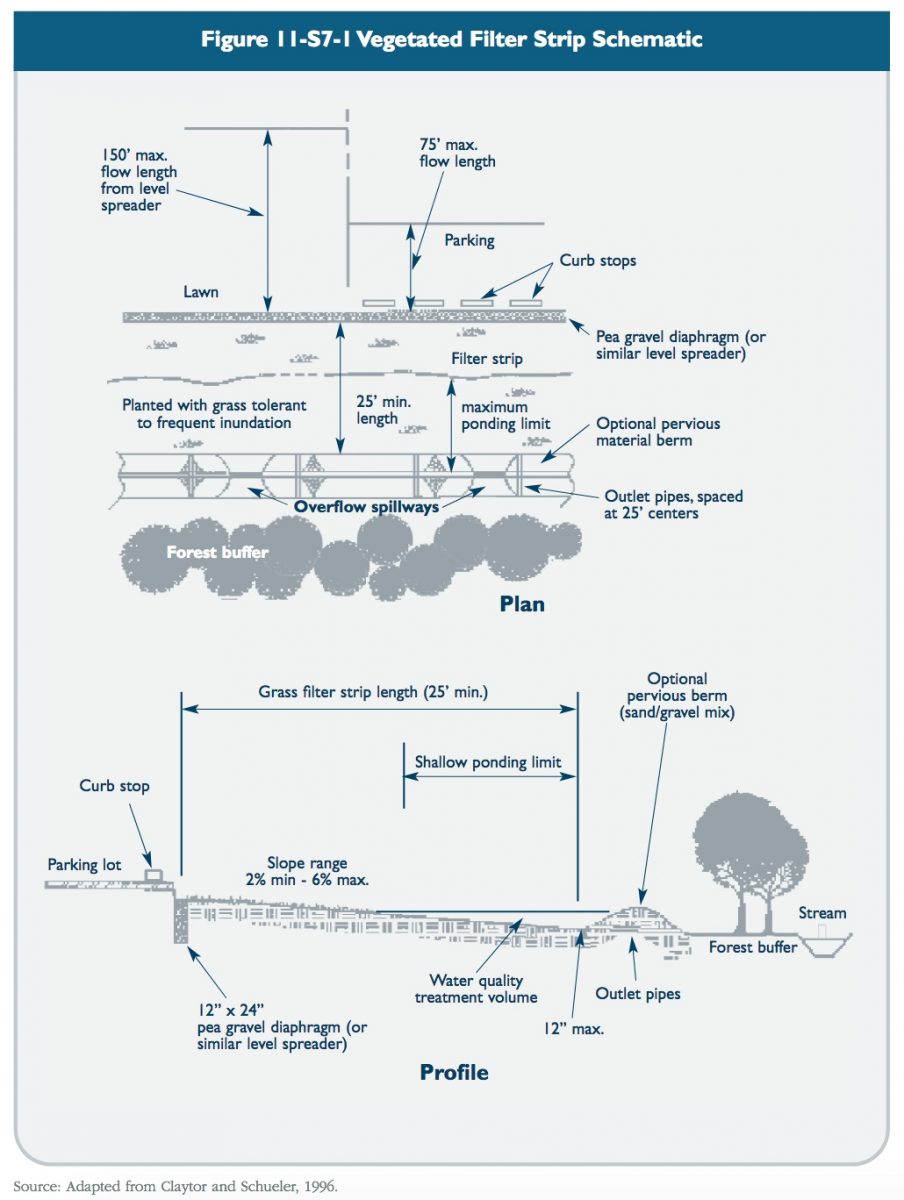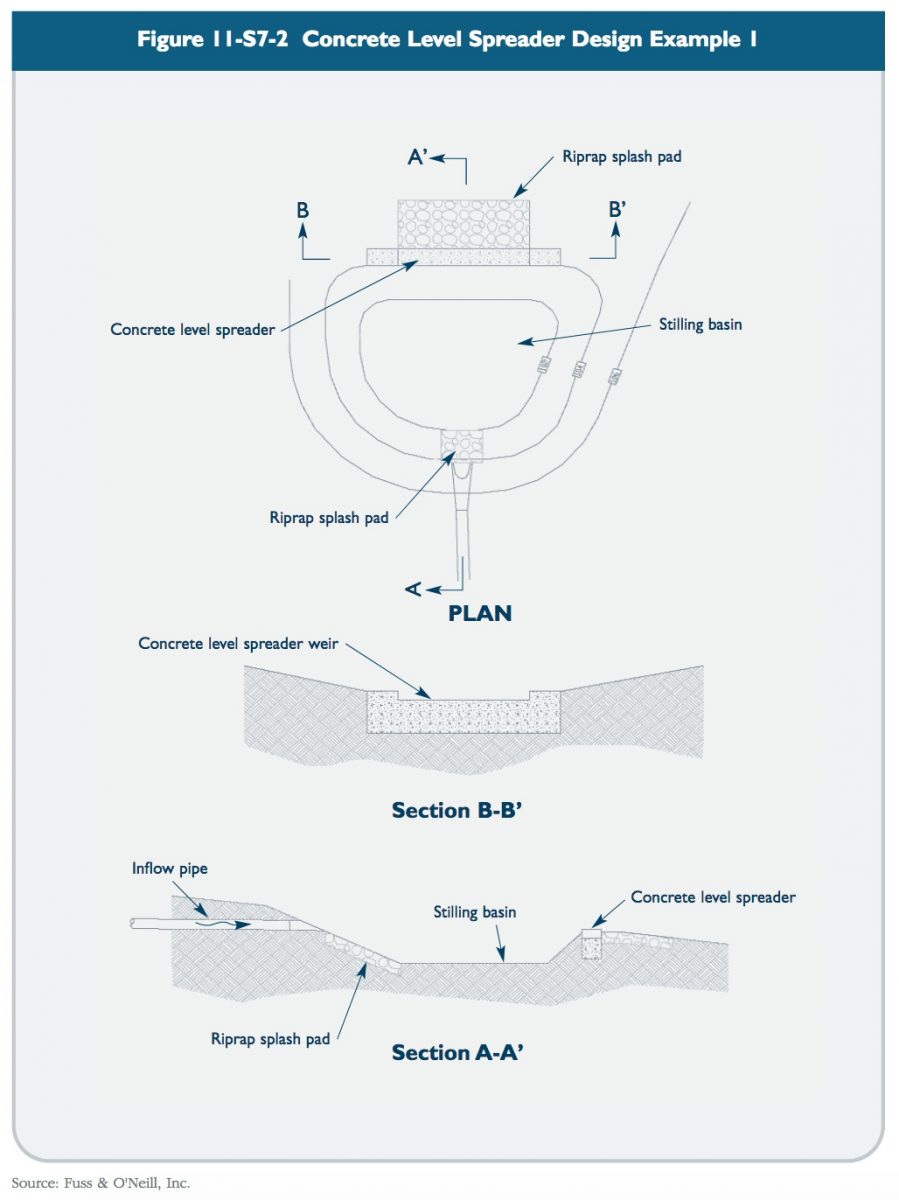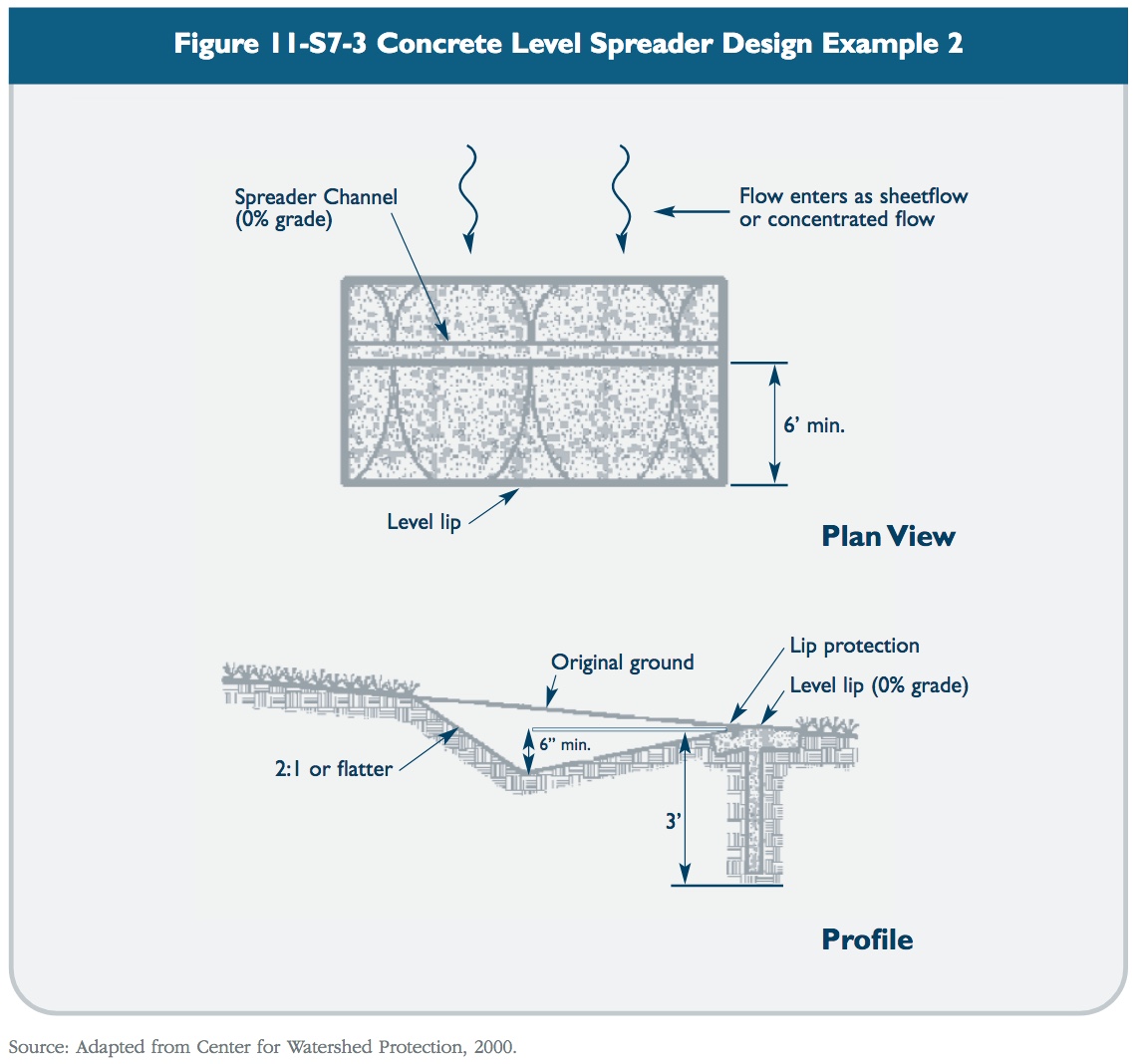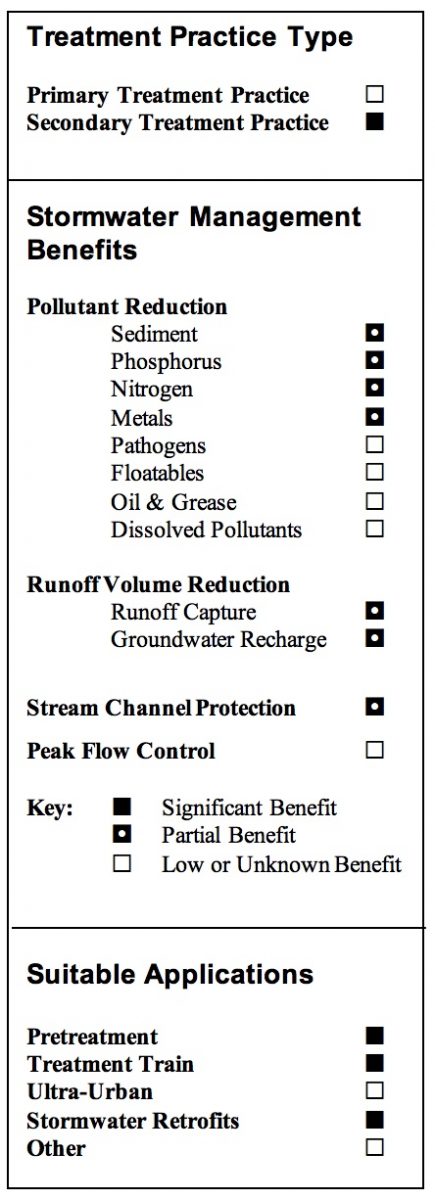Description
Vegetated filter strips, also known as filter strips and grass filters, are uniformly graded vegetated surfaces (i.e., grass or close-growing native vegetation) located between pollutant source areas and downstream receiving waters or wetlands. Vegetated filter strips typically treat sheet flow directly from adjacent impervious surfaces, or small concentrated flows can be distributed along the width of the strip using a level spreader. Vegetated filter strips are designed to slow runoff velocities, trap sediment, and promote infiltration, thereby reducing runoff volumes.
Vegetated filter strips are commonly used as pretreatment prior to discharge to other filtering practices or bioretention systems. They can also be placed downgradient of stormwater outfalls equipped with outlet protection and level spreaders to reduce flow velocities and promote infiltration/filtration. Filter strips are effective when used in the outer zone of a stream buffer (see Chapter Four) to provide pretreatment of runoff from adjacent developed areas (EPA, 1999). In general, vegetated filter strips are relatively inexpensive to install, have relatively low maintenance requirements, but require large amounts of land.
Reasons for Limited Use
* Provide limited pollutant removal. Filter strips are difficult to monitor, and therefore there is limited data on their pollutant removal effectiveness (Metropolitan Council,
2001). Little or no treatment is provided if the filter strip is short-circuited by concentrated flows.
* Applicable to small drainage areas.
* Proper maintenance required for maintaining a healthy stand of dense vegetation and preventing formation of concentrated flow.
* Poor retrofit option due to large land requirements.
* Effective only on drainage areas with gentle slopes (<15 percent).
* Improper grading can render the practice ineffective for pollutant removal (EPA, 2002).
* Not suitable for stormwater runoff from land uses or activities with the potential for high sediment or pollutant loads due to the risk of groundwater contamination or damage to vegetation.
Suitable Applications
* In conjunction with other stormwater management practices to treat runoff from highways, roads, and small parking lots.
* To infiltrate and filter runoff from residential areas such as roof downspouts, driveways, and lawns. Filter strips are relatively easy to incorporate into most residential developments.
* To reduce directly connected impervious area, and thus runoff volume and peak flows.
* In stormwater retrofit applications where land is available. Existing outfalls may be suitable candidates for installation of level spreaders to distribute flow and reduce erosive velocities. Use of filter strips and level spreaders at large outfalls or outfalls with significant flow velocities is not recommended due to the difficulty associated with converting erosive concentrated flows into sheet flow.
* In conjunction with bioretention areas or stream buffer systems to provide pretreatment and reduce erosive runoff velocities.
* As side slopes of grass drainage channels or water quality swales, particularly where sufficient land area is available such as highway medians and shoulders.
Design Considerations
* Slope: Should be designed on slopes between 2 and 6 percent. Steeper slopes encourage the formation of concentrated flow. Flatter slopes encourage ponding and potential mosquito breeding habitat (EPA, 2002).
* Soils: Should not be used on soils with high clay content due to limited infiltration or on soils that cannot sustain grass cover.
* Drainage Area: The contributing drainage area to vegetated filter strips is generally limited to one acre or less. The length of flow, rather than the drainage area, is considered to be the limiting design factor due to the formation of high-velocity concentrated flow. Without the use of a level spreader, the maximum overland flow lengths to the filter strip generally should be limited to 150 feet for pervious surfaces and 75 feet for impervious surfaces. Longer overland flow lengths are acceptable if a level spreader is used.
* Water Table/Bedrock: Vegetated filter strips should be separated from seasonally high groundwater and bedrock by between 2 and 4 feet, as documented by on-site soil testing, to reduce the potential for groundwater contamination and saturated soil conditions between storms.
* Size: The top and toe of slope should be designed as flat as possible to encourage sheet flow and infiltration. The filter strip should be at least 25 feet long and generally as wide as the area draining to the strip. The filter strip should be designed to drain within 24 hours after a storm. The design flow depth should not exceed 0.5 inches. The design should incorporate a bypass system to accommodate flows from larger storms (i.e., 2 year storm or larger). A pervious berm of sand or gravel can be added at the toe of the slope to enhance pollutant removal. In this design, the filter strip should be sized to provide surface storage of the water quality volume behind the berm. Figure 11-S7-1 shows a common filter strip design for the edge of a lawn or parking lot.

* Vegetation: Grasses should be selected to withstand relatively high flow velocities and both wet and dry conditions.
* Level Spreader: A level spreader should be used at the top of slope to distribute overland flow or concentrated runoff (see the maximum overland flow length guidelines above) evenly across the entire length of the filter strip. Many level spreader design variations exist, including level trenches (e.g., pea gravel diaphragms, see Figure 11-S7-1), curbing, concrete weirs, etc. The key to any level spreader design is a continuous overflow elevation along the entire width of the filter strip. Velocity dissipation (i.e., riprap) may be required for concentrated flows. Figure 11-S7-2 and Figure 11-S7-3 show examples of two concrete level spreader designs.


* Construction: Proper grading is essential to establish sheet flow from the level spreader and throughout the filter strip. Soil stabilization measures should be implemented until permanent vegetation is established.
* Operation and Maintenance: Regular maintenance is critical for the effectiveness of filter strips, especially to ensure that flow does not short-circuit the system. Semi-annual inspections are recommended during the first year (and annually thereafter), including inspection of the level spreader for sediment buildup and inspection of the vegetation for erosion, bare spots, and overall health. Regular, frequent mowing of the grass to a height of 3 to 4 inches is required. Sediment should be removed from the toe of slope or level spreader, and bare spots should be reseeded as necessary.
Plans for vegetated filter strips and level spreaders should identify detailed inspection and maintenance requirements, inspection and maintenance schedules, and those parties responsible for maintenance.
References
Claytor, R.A. and T.R. Schueler. 1996. Design of Stormwater Filtering Systems. Center for Watershed Protection. Silver Spring, Maryland.
Metropolitan Council. 2001. Minnesota Urban Small Sites BMP Manual: Stormwater Best Management Practices for Cold Climates. Prepared by Barr Engineering Company. St. Paul, Minnesota.
New York State Department of Environmental Conservation (NYDEC). 2001. New York State Stormwater Management Design Manual. Prepared by Center for Watershed Protection. Albany, New York.
United States Environmental Protection Agency (EPA). 1999. Preliminary Data Summary of Urban Storm Water Best Management Practices. EPA 821-R99-012.
United States Environmental Protection Agency (EPA). 2002. National Menu of Best Management Practices for Stormwater Phase II.
URL:http://www.epa.gov/npdes/menuofbmps/menu.htm, Last Modified January 24, 2002.
